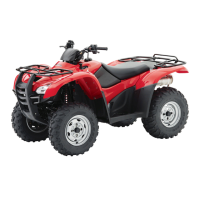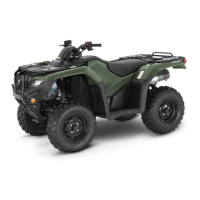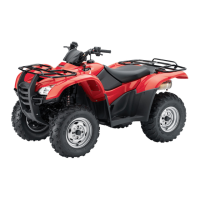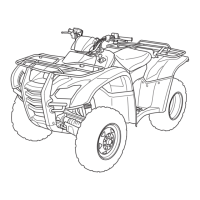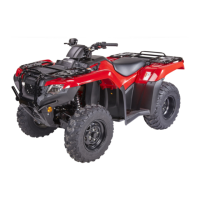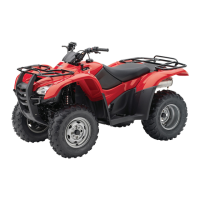Do you have a question about the Honda TRX420FA1 and is the answer not in the manual?
Outlines initial checks, exercises, and familiarization with controls before riding.
Advises on awareness of special situations and satisfactory behavior during use.
Explains the importance and meaning of safety labels and messages on the ATV.
Defines the meaning of DANGER, WARNING, and CAUTION signal words used in the manual.
Provides critical safety recommendations, including age, helmet use, and passenger restrictions.
Describes the meanings of various safety labels found on the ED type ATV.
Explains the safety information conveyed by labels on the U type ATV.
Identifies the location of all ATV controls and components for easy reference.
Explains the function of various dashboard indicators and displays for rider information.
Covers operation of ignition, engine stop switch, and start button for engine control.
Details throttle lever, gearshift switches, drive mode selection, and reverse operation.
Explains the operation of front and rear brakes, parking brake, and related adjustments.
Covers personal preparedness, protective apparel, training, age, and passenger rules.
Outlines essential checks for fuel, tires, lights, and other components before riding.
Specifies maximum weight capacities and guidelines for safely carrying cargo and towing.
Provides guidance on using Honda genuine accessories and the impact of vehicle modifications.
Essential safety rules and warnings for operating the ATV, including off-road use and rider conduct.
Provides step-by-step instructions for starting the engine, normal stops, and emergency shutdown.
Explains selecting drive modes and shifting gears manually or automatically.
Details how to effectively use front and rear brakes for stopping and slowing the ATV.
Covers techniques for turning, skidding, hill riding, and obstacle navigation.
Explains why regular maintenance is critical for safety, performance, and longevity.
Identifies component locations and describes procedures for removing covers to access parts for service.
Specifies fuel type, octane rating, tank capacity, and refueling procedures.
Specifies the API classification, viscosity, and standards for engine oil.
Provides steps for checking, adding, and changing engine oil and filter.
Details the oil type, viscosity, and changing procedure for the rear final gear.
Outlines the oil type, viscosity, and changing procedure for the front final gear.
Specifies coolant type, checking levels, and adding coolant.
Explains coolant replacement and radiator cleaning procedures.
Step-by-step guide for removing, cleaning, drying, and oiling the air cleaner element.
Instructions for servicing and cleaning the drain tube in the air cleaner housing.
Details inspecting and adjusting throttle lever freeplay and cable condition.
Provides instructions for checking and adjusting the freeplay of the reverse assist lever.
Specifies plug type, inspection, and replacement procedures.
Explains how to check intake and exhaust valve clearances and consequences of incorrect settings.
Describes the procedure for periodically cleaning the spark arrester to remove carbon buildup.
Explains how to adjust spring pre-load for rider weight and riding conditions.
Details the 5-position adjustment mechanism for front and rear shock springs.
Covers recommended brake fluid and procedures for checking the fluid level.
Details how to inspect front brake pads and rear brake shoes for wear.
Explains how to adjust the freeplay for both the rear brake pedal and lever.
Provides instructions for adjusting the rear brake light switch timing.
Stresses the importance of correct tire pressure for safety, handling, and tread life.
Guides on checking tires for bumps, cuts, cracks, foreign objects, and tread wear.
Covers temporary repairs, permanent repairs, and the process of replacing tires.
Details the function and inspection of engine guards and skid plates for frame protection.
Covers inspection of front boot guards and driveshaft guards for damage or looseness.
Advises checking propeller shaft and yoke joint boots for damage or grease leaks.
Guides on checking front driveshaft boots for cuts, damage, or leaks.
Covers battery maintenance, storage recommendations, and precautions.
Explains how to charge the battery using a recommended charger to maintain its life.
Provides guidelines on cleaning agents, washing techniques, and environmental considerations.
Details methods for washing with detergent and using spray cleaners for different ATV conditions.
Explains how to clean the exhaust pipe and muffler to remove stains and dirt.
Provides advice on planning rides, including maps, permits, and essential items to bring.
Details safe methods for transporting the ATV and procedures for long-term storage.
Offers tips on responsible ATV ownership, including tread lightly and proper waste disposal.
Provides advice on how to assess and address problems encountered while riding.
Addresses common problems like the engine not starting or running poorly.
Covers troubleshooting for transmission problems and manual gear selection.
Details procedures for handling flat tires, including emergency wheel removal and installation.
Addresses overheating indicators and troubleshooting blown fuses in the electrical system.
Outlines steps to take after a crash and what to do if the key is lost.
Discusses issues related to low battery charge and general component failures.
Details vehicle identification numbers (VIN, Engine No.) and key technical specifications.
Provides advice on initial break-in procedures and guidelines for using petrol containing alcohol.
Lists the manufacturer's details and the authorized representative for the EU market.
Outlines initial checks, exercises, and familiarization with controls before riding.
Advises on awareness of special situations and satisfactory behavior during use.
Explains the importance and meaning of safety labels and messages on the ATV.
Defines the meaning of DANGER, WARNING, and CAUTION signal words used in the manual.
Provides critical safety recommendations, including age, helmet use, and passenger restrictions.
Describes the meanings of various safety labels found on the ED type ATV.
Explains the safety information conveyed by labels on the U type ATV.
Identifies the location of all ATV controls and components for easy reference.
Explains the function of various dashboard indicators and displays for rider information.
Covers operation of ignition, engine stop switch, and start button for engine control.
Details throttle lever, gearshift switches, drive mode selection, and reverse operation.
Explains the operation of front and rear brakes, parking brake, and related adjustments.
Covers personal preparedness, protective apparel, training, age, and passenger rules.
Outlines essential checks for fuel, tires, lights, and other components before riding.
Specifies maximum weight capacities and guidelines for safely carrying cargo and towing.
Provides guidance on using Honda genuine accessories and the impact of vehicle modifications.
Essential safety rules and warnings for operating the ATV, including off-road use and rider conduct.
Provides step-by-step instructions for starting the engine, normal stops, and emergency shutdown.
Explains selecting drive modes and shifting gears manually or automatically.
Details how to effectively use front and rear brakes for stopping and slowing the ATV.
Covers techniques for turning, skidding, hill riding, and obstacle navigation.
Explains why regular maintenance is critical for safety, performance, and longevity.
Identifies component locations and describes procedures for removing covers to access parts for service.
Specifies fuel type, octane rating, tank capacity, and refueling procedures.
Specifies the API classification, viscosity, and standards for engine oil.
Provides steps for checking, adding, and changing engine oil and filter.
Details the oil type, viscosity, and changing procedure for the rear final gear.
Outlines the oil type, viscosity, and changing procedure for the front final gear.
Specifies coolant type, checking levels, and adding coolant.
Explains coolant replacement and radiator cleaning procedures.
Step-by-step guide for removing, cleaning, drying, and oiling the air cleaner element.
Instructions for servicing and cleaning the drain tube in the air cleaner housing.
Details inspecting and adjusting throttle lever freeplay and cable condition.
Provides instructions for checking and adjusting the freeplay of the reverse assist lever.
Specifies plug type, inspection, and replacement procedures.
Explains how to check intake and exhaust valve clearances and consequences of incorrect settings.
Describes the procedure for periodically cleaning the spark arrester to remove carbon buildup.
Explains how to adjust spring pre-load for rider weight and riding conditions.
Details the 5-position adjustment mechanism for front and rear shock springs.
Covers recommended brake fluid and procedures for checking the fluid level.
Details how to inspect front brake pads and rear brake shoes for wear.
Explains how to adjust the freeplay for both the rear brake pedal and lever.
Provides instructions for adjusting the rear brake light switch timing.
Stresses the importance of correct tire pressure for safety, handling, and tread life.
Guides on checking tires for bumps, cuts, cracks, foreign objects, and tread wear.
Covers temporary repairs, permanent repairs, and the process of replacing tires.
Details the function and inspection of engine guards and skid plates for frame protection.
Covers inspection of front boot guards and driveshaft guards for damage or looseness.
Advises checking propeller shaft and yoke joint boots for damage or grease leaks.
Guides on checking front driveshaft boots for cuts, damage, or leaks.
Covers battery maintenance, storage recommendations, and precautions.
Explains how to charge the battery using a recommended charger to maintain its life.
Provides guidelines on cleaning agents, washing techniques, and environmental considerations.
Details methods for washing with detergent and using spray cleaners for different ATV conditions.
Explains how to clean the exhaust pipe and muffler to remove stains and dirt.
Provides advice on planning rides, including maps, permits, and essential items to bring.
Details safe methods for transporting the ATV and procedures for long-term storage.
Offers tips on responsible ATV ownership, including tread lightly and proper waste disposal.
Provides advice on how to assess and address problems encountered while riding.
Addresses common problems like the engine not starting or running poorly.
Covers troubleshooting for transmission problems and manual gear selection.
Details procedures for handling flat tires, including emergency wheel removal and installation.
Addresses overheating indicators and troubleshooting blown fuses in the electrical system.
Outlines steps to take after a crash and what to do if the key is lost.
Discusses issues related to low battery charge and general component failures.
Details vehicle identification numbers (VIN, Engine No.) and key technical specifications.
Provides advice on initial break-in procedures and guidelines for using petrol containing alcohol.
Lists the manufacturer's details and the authorized representative for the EU market.
| Brand | Honda |
|---|---|
| Model | TRX420FA1 |
| Category | Offroad Vehicle |
| Language | English |


